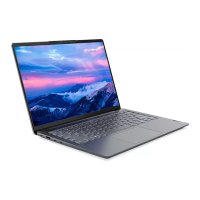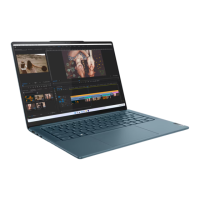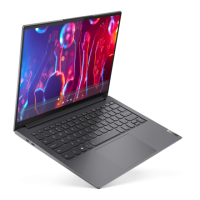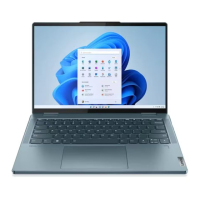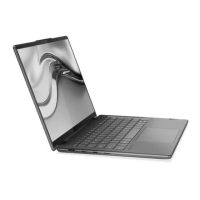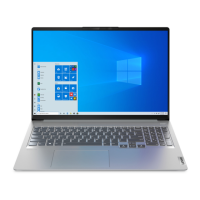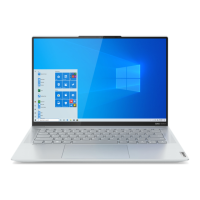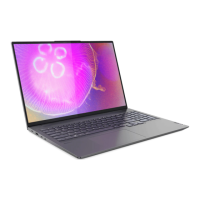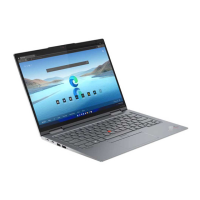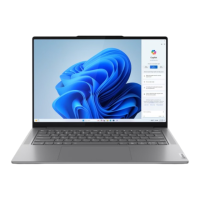
Do you have a question about the Lenovo Yoga 7 2-in-1 and is the answer not in the manual?
| Category | 2-in-1 Laptop |
|---|---|
| Operating System | Windows 11 Home |
| Touchscreen | Yes |
| Battery | 71Wh |
| Series | Yoga |
| RAM | 16GB |
| Storage | 512GB SSD |
| Display Size | 14" |
| Graphics | AMD Radeon Graphics |
| Wireless | Wi-Fi 6 |
| Color | Storm Grey |
| Ports | 1 x Headphone / mic combo |
Describes the front view of the computer, including microphones, LEDs, camera, and screen.
Details components on the base of the computer, such as antennas, speakers, keyboard, and touchpad.
Shows ports on the left side of the computer, including HDMI, USB Type-C, and audio jack.
Details ports on the right side, like power light, power button, microSD slot, and USB-A connectors.
Covers the rear components, specifically air vents (outlet).
Describes the bottom of the computer, including air vents (intake) and the Novo button hole.
Lists detailed technical specifications for the computer models.
Explains USB transfer rates and factors affecting them.
Provides specifications for operating temperature, altitude, and humidity.
Introduces basic Windows settings and configurations for the computer.
Guides users on how to access Windows help and troubleshooting resources.
Explains Lenovo management applications for system updates and settings.
Describes the different computer modes (Notebook, Stand, Tent, Tablet) and their suitable uses.
Covers interacting with the computer, including the Lenovo Digital Pen.
Details how to use and configure the optional Lenovo Digital Pen.
Explains how to configure settings for the Lenovo Digital Pen in Windows.
Describes the function of hotkeys on the keyboard and how to use them.
Explains the FnLock switch functionality for toggling hotkeys.
Lists hidden functions accessible via key combinations without printed icons.
Describes the optional numeric keypad and its usage.
Details various touch gestures supported by Windows for screen interaction.
Explains how to use gestures for volume and brightness control on touch screen/touchpad.
Describes Super Resolution feature for enhancing video quality.
Explains Eye Care Mode for adjusting screen color temperature.
Details Smart Noise Cancelling feature for audio optimization.
Covers power management settings for optimal performance and efficiency.
Explains the computer's rechargeable battery pack and its charging capabilities.
Describes Normal, Rapid, Conservation, and Overnight battery charging modes.
Provides steps to restore the battery's full charging capacity.
Guides on how to customize the power button's function (sleep, shutdown, etc.).
Explains power plans and their role in managing system power.
Instructions on how to modify existing power plans.
Details different performance modes (e.g., High Performance, Auto, Power Saving).
Explains how to adjust screen refresh rates for smoother visuals.
Introduces the UEFI/BIOS setup utility and its functions.
Defines the UEFI/BIOS and its purpose in system initialization.
Provides steps to access the UEFI/BIOS setup interface.
Guides on how to select boot devices and change boot order.
Instructions on modifying the hotkey behavior in UEFI/BIOS.
Details how to enable/disable the always-on USB function.
Explains how to set various passwords (Admin, User, HDD) in the UEFI/BIOS.
Lists and describes different password types available in UEFI/BIOS.
Provides steps to set an administrator password for UEFI/BIOS access.
Instructions on how to modify or delete the administrator password.
Guides on setting a user password for limited UEFI/BIOS access.
Explains how to set a password that prompts on system startup.
Details how to set a password to protect the hard disk drive.
Instructions on modifying or removing the hard disk password.
Addresses common user questions about partitioning, system responsiveness, and liquid spills.
Lists various resources for self-help and troubleshooting, including links and software.
Defines Customer Replaceable Units (CRUs) and their types for product maintenance.
Lists specific CRUs for the product model and their replacement types.
Explains the functions of various hotkey icons found on the keyboard.
Contains legal notices, disclaimers, and copyright information about the document.
Lists trademarks of Lenovo and other companies associated with the product.
